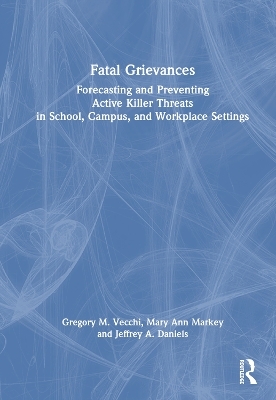
Fatal Grievances
Routledge (Verlag)
978-0-367-13908-7 (ISBN)
Active killer attacks frequently dominate the headlines with stories of seemingly random mass killings in school, campus, and workplace settings. Nearly all of the attacks are over before the police can respond, leaving unanswered questions as to why these attacks happen and what can be done to prevent them. Fatal Grievances: Forecasting and Preventing Active Killer Threats in School, Campus, and Workplace Settings takes a proactive view of active killer threat management and resolution to prevent the attack before it occurs.
Drawing from established threat assessment, behavioral analysis, and law enforcement negotiation theory and practice, the book presents models and methods designed to forecast and prevent an active killer attack through the process of identification, assessment, and engagement. This approach begins with definitions and orientations to violence, the importance of the primacy of focusing on direct behaviors of planned lethal violence over other more indirect behaviors, understanding how to identify a fatal grievance and that only fatal grievances result in planned lethal violence, the importance of understanding the process of crisis intervention as the key to eliminating the fatal grievance and the motivation to kill, and the use of time-series predictive behavioral threat forecasting methods to prevent an active killer attack. Case studies from within the United States (US) and abroad support this unique approach to threat assessment and make the concepts and principles accessible to professionals working in the fields of education, human resources, and security.
Gregory M. Vecchi earned a B.S. in Management/Human Resources from Park University, Parkville, Missouri, an M.S. in Criminal Justice from the University of Alabama, Tuscaloosa, Alabama, and a Ph.D. in Conflict Analysis and Resolution from Nova Southeastern University, Fort Lauderdale, Florida. He currently serves as a Professor of Criminal Justice and Homeland Security at Keiser University, Fort Lauderdale, Florida, and he is the Principal of VGI Consulting and Training. Dr. Vecchi has over 30 years of law enforcement experience. Dr. Vecchi formerly served as the Chief of the FBI Behavioral Science Unit and career FBI negotiator. In these positions, he gained extensive experience assessing and interacting with violent offenders, as well as researching, training, and conducting threat assessments. Dr. Vecchi has conducted dozens of workplace threat assessments for Fortune 500 companies. Mary Ann Markey received a B.A. in Psychology and an M.A. in Psychology from Florida Atlantic University, Boca Raton, Florida, and Ph.D. in Conflict Analysis and Resolution from Nova Southeastern University, Fort Lauderdale, Florida. She currently serves as an Adjunct Professor of Psychology at Ringling College of Art and Design, Sarasota, Florida while continuing to conduct research on intra-family violence and homicide, mass murder, and serial murder. Jeffrey A. Daniels earned a B.A. in Psychology at Metropolitan State University, Denver, Colorado, an M.S. in Counseling Psychology from Central Washington University, Ellensburg, Washington, and a Ph.D. in Counseling Psychology from the University of Nebraska, Lincoln, Nebraska. He is currently a professor in the School of Counseling and Well-Being at West Virginia University, Morgantown, West Virginia. Dr. Daniels has been engaged in research pertaining to violence and violence prevention for over 23 years and he has engaged in collaborative research with the FBI for over 16 years using Perpetrator-Motive Research Design.
Preface
Chapter 1. Introduction And Orientation to Active Killer Threat Assessment
Scope of this book
A paradigm shift from active shooters to active killers
A change in mindset from being reactive to proactive
Assessment versus analysis
Threat intelligence collection and assessment
The problem with "profiling" active killers
The importance of operationalizing definitions
Chapter 2. Active Killer Characteristics: Myths Vs. Statistics
Myth 1: active killers are everywhere
Myth 2: active killers are only a problem in the United States
Myth 3: disgruntled students and employees are the only threat to safety
Myth 4: the attacker just "snapped"
Myth 5: demographics can identify an active killer
Chapter 3. Direct Behaviors of Planned Lethal Violence
Active killer motivations
Grievance as a precursor of lethal violence
Grievance and the crisis state
The fatal grievance pathway
Planned lethal violence
Direct behaviors and stages of planned lethal violence
Direct behavioral clusters of planned lethal violence
The planned lethal violence stairway model
Chapter 4. Indirect Behavioral Indicators of Planned Lethal Violence And Situational Distressors
Indirect behaviors
Primary indirect behavioral indicators
Secondary indirect behavioral indicators
Stress and violence
Situational distress
Situational distressors
Chapter 5. Threat Management and Resolution: Identifying The Threat
The necessity of structure in active killer threat assessment
Forensic investigation and behavioral analytical methods
Contextual factors
Factors of social desirability
The role of social fabric in threat assessment
Detecting behavioral indicators of planned lethal violence
Baselines and anomalies
Establishing baselines and identifying anomalies
Bias and error considerations in detecting concerning behavior
Chapter 6. Threat Management and Resolution: Assessing The Threat
The problem with relying on "pre-attack behaviors" in threat assessment
Understanding significancy and frequency of anomalies
Prediction and threat assessment
Forecasting in threat assessment
Qualitative and quantitative forecasting
Predictive analytics and modeling
Predictive behavioral threat forecasting
Methodology
Qualitative adjustments to threat confidence levels
Completing the threat assessment
Bias errors in assessing a threat
Chapter 7. Threat Management and Resolution: Engaging The Threat
Conflict management vs. conflict resolution
Monitoring
Third-party intervention
Direct interventions
Engagements based on threat level
Chapter 8. Limitations And Conclusion
Summary of key takeaways
Limitations
Appendix A
Appendix B
Appendix C
Index
References
| Erscheinungsdatum | 12.12.2022 |
|---|---|
| Zusatzinfo | 16 Tables, black and white; 26 Line drawings, black and white; 26 Illustrations, black and white |
| Verlagsort | London |
| Sprache | englisch |
| Maße | 178 x 254 mm |
| Gewicht | 508 g |
| Themenwelt | Geisteswissenschaften ► Psychologie ► Allgemeine Psychologie |
| Geisteswissenschaften ► Psychologie ► Arbeits- und Organisationspsychologie | |
| Medizin / Pharmazie ► Medizinische Fachgebiete ► Psychiatrie / Psychotherapie | |
| ISBN-10 | 0-367-13908-1 / 0367139081 |
| ISBN-13 | 978-0-367-13908-7 / 9780367139087 |
| Zustand | Neuware |
| Haben Sie eine Frage zum Produkt? |
aus dem Bereich


